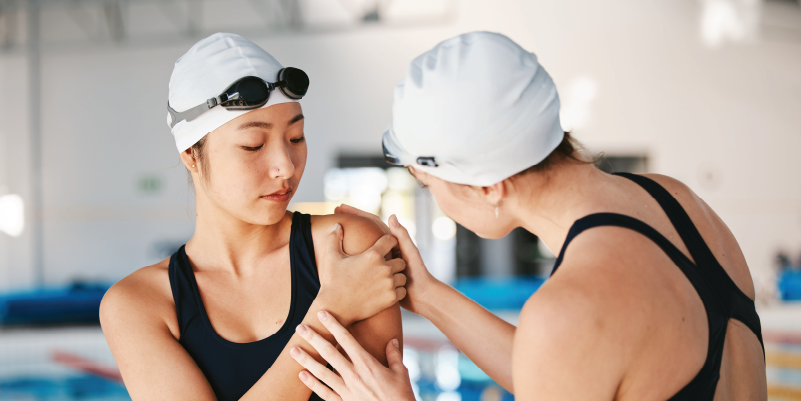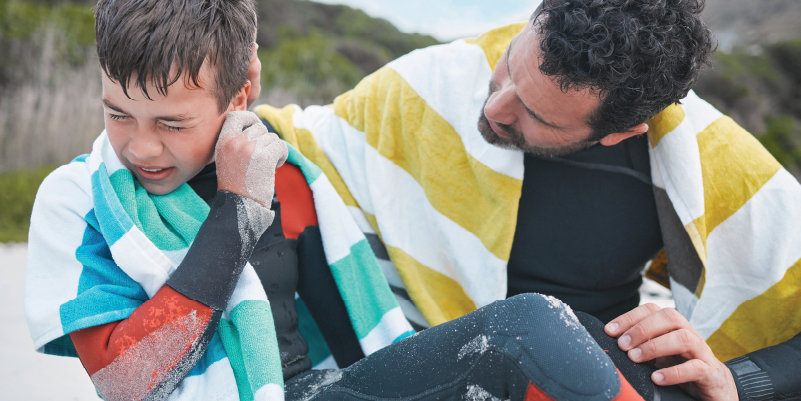Swimming is a fantastic way to stay fit, enjoy the water, and beat the heat during the summer months. However, like any physical activity, swimming carries the risk of injuries. Whether you’re a beginner or an experienced swimmer, it’s essential to be aware of common injuries and take preventive measures to stay safe and maintain your aquatic adventures without interruption. In this blog post, we’ll explore some common swimming injuries and their causes and offer tips on preventing and managing them. Let’s dive in!
Causes of Swimming Injuries
Swimming injuries can occur due to various factors that must be considered to prevent recurring issues. Overestimating the workout swimming can lead to overworking muscles and increasing the risk of injury. Being mindful of your body’s strength and stamina is crucial to avoid swimming-related injuries. Some common causes include:
- Poor swimming technique
- Overuse and lack of rest
- Inadequate warm-up and stretching
- A sudden increase in training intensity
- Lack of training and conditioning
- Insufficient recovery and rehabilitation
Neglecting warm-up exercises and proper stretching before swimming can leave your body unprepared for the physical demands of the activity, increasing the likelihood of injury. It’s essential to pay attention to using the correct technique to prevent excessive strain on muscles. Pushing the body beyond its limits without allowing for proper recovery can strain muscles, tendons, and joints, leading to overuse injuries.
External factors such as water temperature and chlorine in pool conditions can also contribute to specific injuries like skin irritations or a swimmer’s ear. Swimmers must be mindful of these causes and take appropriate measures to prevent injuries, including improving technique, gradually increasing training intensity, incorporating proper warm-up and stretching routines, and maintaining overall physical fitness.
Types of Swimming Injuries
Swimming injuries can range from minor discomfort to more serious conditions that require medical attention. Some of the most common swimming injuries include:
Shoulder Injuries
Shoulder injuries are the most common type of injury obtained through swimming, typically in the form of rotator cuff impingement, bicep tendonitis, or a swimmer’s shoulder. The repetitive motions involved in swimming with techniques such as freestyle and butterfly strokes, place incredible stress on your rotator cuff and scapular muscles. Your rotator cuff involves a group of muscles and tendons that stabilize the shoulder joint, and your scapular muscles are directly responsible for stabilizing the shoulder blade while performing the overhead motions required for many swimming techniques.

Over time, this continuous strain can lead to shoulder pain, inflammation, and a decreased range of motion. Focusing on proper technique and doing exercises that strengthen the shoulder muscles can effectively prevent and manage shoulder injuries.
Knee Injuries
For competitive swimmers who are particularly fond of the breaststroke, they are susceptible to conditions like the swimmer’s knee. The breaststroke involves a frog-like kicking motion that places stress on the knee joints and leads to injuring the ligaments, tendons, and cartilage around the knee. Improper knee alignment, excessive kicking force, and inadequate strength and flexibility in the muscles surrounding the knee can contribute to developing knee injuries. As a result, it can cause significant knee pain, inflammation, and reduced knee function.
Maintaining proper technique, avoiding hyperextension of the knee during the breaststroke, and strengthening the muscles supporting the knee joint can help with knee injury prevention. Even if you’re devoted to the breaststroke, we recommend incorporating other swimming techniques into your training routine to balance your workout and avoid overuse injuries.
Lower Back Pain
There are a few ways to obtain a lower back injury from swimming, including poor body position and alignment in the water. When your body is arched or excessively extended back while swimming, it puts unnecessary stress and strain on the muscles in your lower back, leading to pain and discomfort. Excessive twisting motions can also strain the muscles and joints in our lower backs; this is seen often in swimmers practicing the freestyle and butterfly techniques.
Weak core muscles are also more susceptible to causing lower back pain since these muscles provide stability and support to the spine, and weak core results in more stress on the lower back while performing swimming motions.
To prevent lower back injuries while swimming, swimmers should focus on maintaining proper body alignment and position, engaging and strengthening the core muscles through specific exercises, and improving flexibility and mobility in the lower back. Cross-training activities targeting the core and lower back muscles, such as pilates, can also help maintain a strong and stable lower back.
Additional Conditions
Frequent swimmers may also experience a swimmer’s ear, an ear canal infection caused by prolonged water exposure. Swimmers also often experience skin dryness, itchiness, and rashes due to chlorine.
Awareness of these typical swimming injuries can help swimmers take appropriate precautions and seek early treatment when necessary, ensuring a safer and more enjoyable swimming experience the next time they enter the water.

Treatment for Swim Injuries
Treating swimming injuries involves a multi-faceted approach to promote healing and recovery. Initially, self-care measures such as resting the injured area and avoiding activities that could aggravate the injury further. Using ice packs or cold compresses on the affected area can reduce pain, inflammation, and swelling. Taking over-the-counter medication to help with pain and inflammation can also be taken. If the injury is minor and you’re a casual swimmer, you shouldn’t need to seek medical attention.
If you’re more than just a casual swimmer and experience severe or recurring injuries, seeking care from a healthcare professional who specializes in sports medicine is advised. They can accurately diagnose and provide comprehensive treatment options. In some cases, physical therapy may help restore strength and improve flexibility and mobility. Once the injury has fully healed, a gradual return to swimming and physical activity is recommended, focusing on proper technique and gradually increasing intensity. It is important to listen to your body, follow medical advice, and be patient with the recovery process for successful treatment.

Seeking Care for Swim Injuries
In the case of a swimming injury, there are some scenarios where seeking emergency care is warranted. If someone experiences:
- Loss of consciousness
- Difficulty breathing
- Suspected spinal injury
- Heavy bleeding from an open wound
- Severe pain/inability to move
- Numbness
- Tingling
- Muscle weakness
- Loss of sensation
It is recommended to immediately seek care at your nearest emergency center. It is always better to stay on the side of caution and seek emergency care when there is uncertainty about the severity of an injury or the potential complications of a common swimming injury.
No matter the time of day, Neighbors are always here to provide care when you need it most. Whether it’s a severe shoulder impingement or a knee strain, Neighbor’s ER offers prompt and efficient care to alleviate pain, promote healing, and help individuals get back into the water as soon as possible. Visit our website to find your closest location!
